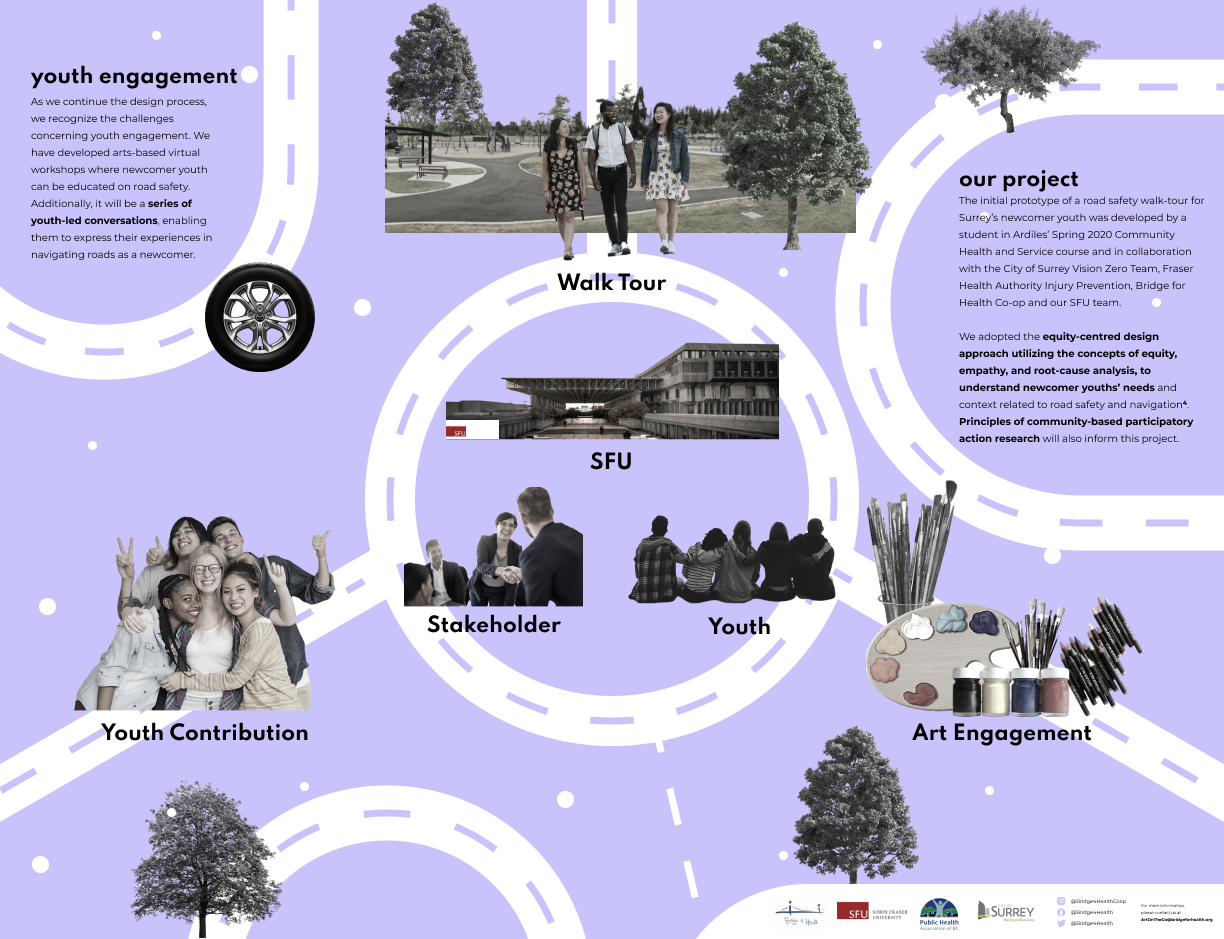A partnership with Simon Fraser University and the Public Health Association of Canada

In Surrey, more traffic-related injuries and fatalities occurred in neighbourhoods with higher percentages of newcomers, averaging between 35% and 54% of the total population (Surrey Local Immigration Partnership, 2014). Between 2017 and 2018, a significant increase in motor vehicle fatalities occurred among youth aged 15 to 24, reaching 2018’s highest proportion of deaths and further emphasizing the need for road safety intervention (RoadSafetyBC, 2019).
Given the rapid growth and diversity across immigrant groups, navigation within transport systems may be challenging. Although most immigrants have advanced proficiency, some may lack the required literacy and language skills to safely navigate the community. Since newcomer youth experience more risk produced by environmental social factors and learn English faster, they face greater responsibilities supporting older family members in navigating these systems and acting as their interpreters (Li, 2012).
Furthermore, the COVID-19 pandemic highlighted several inequities, and newcomer youth are impacted more than ever since opportunities for connection and access to information are greatly reduced, which are some of the barriers that newcomer youth commonly face.
Using principles of community-based participatory action research and the equity-centred design, we developed an initial prototype of a road safety walk-tour for Surrey’s newcomer youth in collaboration with the City of Surrey Vision Zero, Fraser Health Authority Injury Prevention, Bridge for Health Co-op and our SFU team. The initial walk-tour prototype will be a peer-led walking tour to key community establishments, including the Surrey City Centre, transit stations, libraries, and parks. The walk tours will support newcomer youth in gaining knowledge and skills related to traffic safety. But importantly, building social connections with one another and the community.
As important feedback mechanisms for our final prototype and to keep us on track with our equity-centred approach, we will conduct qualitative semi-structured interviews and arts-based workshops with newcomer youth. In the arts-based virtual workshops, newcomer youth can take part in a road-safety painting activity. Additionally, it will be a series of youth-led conversations, enabling them to express their experiences in navigating roads as a newcomer.
So far, we have reviewed literature and existing data showcasing the emerging need for road safety interventions for newcomer youth in Surrey. We have also engaged with 30 youth from Ardiles’ Spring 2021 Community and Health Service course at Simon Fraser University and a few community organizations such as MOSAIC BC, Options Community Services Society and Surrey Schools to introduce our project and to gain more insight into the existing gaps and barriers surrounding newcomer youth engagement and road safety.
Ultimately, we aim to engage newcomer youth in dialogue related to traffic safety, promote community resource information sharing among youth and extended family networks, and improve newcomers’ well-being through meaningful community relationships. In five years, we hope that Surrey will see a significant reduction in traffic-related injuries and fatalities, and newcomer youth will be more informed to collaboratively engage in Surrey’s road safety and navigation efforts.

How it is relevant to promoting equity:
As racialized community members residing in Surrey, we are aware of the City’s needs, including the need to promote road safety, particularly among newcomer youth aged 18 to 21. Furthermore, as first-generation immigrants ourselves, we understand the challenges newcomer youths face, particularly in navigating unfamiliar cultural contexts and establishing new connections.
The COVID-19 pandemic highlighted several inequities, and newcomer youth are impacted more than ever since opportunities for connection and access to information are greatly reduced, which are some of the barriers that newcomer youth commonly face, even before the pandemic.
We adopted the equity-centred design approach to develop our initial walk-tour prototype utilizing the concepts of equity, empathy, and root-cause analysis, to understand newcomer youths’ needs and context related to road safety and navigation (Pinedo, 2020). Principles of community-based participatory action research will also inform this project, and a community advisory committee with newcomer youth and stakeholders will guide our actions.
Our arts-based workshops and qualitative interviews with newcomer youth will serve as an important feedback mechanism for our final prototype and keep us on track with our equity-centred approach. The results from this data collection will improve our proposed peer-led walking tour prototype and advance our knowledge on the lived experiences of youth newcomers in Surrey, B.C. Participation of youth in this preliminary data collection will also allow for meaningful youth engagement as it provides them with the opportunity to connect with other youth newcomers and foster a sense of belonging within the community.
ArtOnTheGo@bridgeforhealth.org
References
- Li G. Literacy Engagement Through Online and Offline Communities Outside School: English Language Learners’ Development as Readers and Writers. Theory Into Practice. 2012;51(4):312–8.
- Pinedo (2020). An introduction to Liberatory Design: How an equity-centered design framework can develop more inclusive designers. Available at:
- https://uxdesign.cc/an-introduction-to-liberatory-design-9f5d3fe69ff9
- Road Safety BC. [Internet]. Motor Vehicle Related Crashes, Injuries and Fatalities. 2019 Nov [cited 2021Feb26]. Available from: https://www2.gov.bc.ca/assets/gov/driving-and-transportation/driving/roadsafetybc/data/motor_vehicle_related_crashed_injuries_fatalities_10-year_statistics_for_british_columbia_2009-2018.pdf
- Surrey Local Immigration Partnership. [Internet]. Who Are Surrey’s Newcomers? 2014 Oct [cited 2021Feb26]. Available from: https://www.surreylip.ca/sites/default/files/LIP-FactSheet01-Who%20are%20Surreys%20Newcomers.pdf
